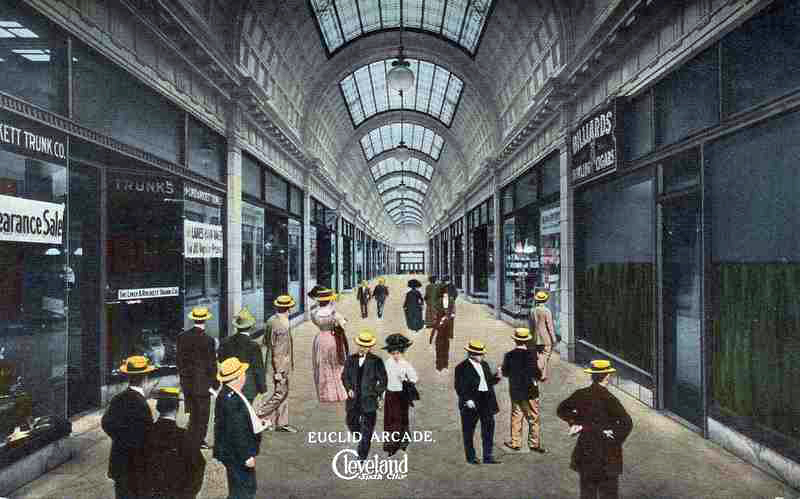The Origins of the Arcade & the Various Types
The origin of the arcade is most likely patterned after the early bazaars found in the middle east. These middle eastern shopping streets are typically covered as protection against the harsh heat from the sun. This design element makes the covered arcade appealing to cities with a cold, hot, or rainy climate.

The design style of arcades found in western culture can also be traced back to the design of the Renaissance street. An early example is the Uffizi Cortile in Florence, designed by Vasari in 1560, the inner courtyard is a designed with mirrored façade, and links the river Arno to Piazza della Signoria.

Arcades as a Building Typology
In the 1983 English translation of “Arcades: The History of a Building Type,” by Johann F. Geist, the arcade is described as a building typology. By studying a large number of arcades Geist is able to illustrate the common characteristics found in these covered passageways.
Common typologies are shown in the diagram below, i.e. …
- Glass Roof Construction Types
- Spatial Types
- Building Types
- Cross Section Types
- Longitudinal Section Types


Arcades in Cleveland
The Cleveland Arcade
In 1870 John D. Rockefeller formally founded the Standard Oil Company, Inc. in Cleveland, Ohio. This formation put Cleveland at the forefront as important cities in the US. In 1870 the population of Cleveland was 92,829 and the city ranked as the 15th largest city in the US. By 1900 the population had quadrupled in size to 381,768 people and was now the 7th largest in the US. Ref. With the advent of wealth pouring into Cleveland development along Euclid Avenue begin to excel rapidly.
In the second half of the 19th century and early in the 20th century, Euclid Avenue was internationally known. Baedeker‘s Travel Guides called the tree-lined avenue “The Showplace of America”, and designated it as a must see for travelers from Europe. The avenue became known as “Millionaire’s Row,” and the concentration of wealth was unparalleled, and the value of the mansions along Euclid Avenue far exceeded the valuation of New York’s Fifth Avenue in the late 19th century.

With all the wealth concentrated on Euclid Avenue it’s easy to understand how the blocks closer to the center would undergo further development. One form of development was the construction of three arcades just east of Public Square.

The construction of the Cleveland Arcade, built in 1890 by Detroit Bridge Co., and designed by the architects John Eisenmann and George H. Smith, was financed by John D. Rockefeller, Marcus Hanna, Charles F. Brush and several other wealthy Clevelanders of the day. The design of the Cleveland Arcade was modeled after the Galleria Vittorio Emanuele II located in Milan.
The Cleveland Arcade is a cross between a lighted court and a commercial shopping street. The building is a complex of three structures: two nine-story office buildings facing out to Euclid and Superior Avenues, connected via the five-story iron-and-glass-enclosed arcade. The Richardsonian arched entrance along Superior Avenue is original, but the Euclid Avenue front was remodeled in 1939 by the firm of Walker and Weeks. The level of the Superior Avenue entrance is about 12 feet (3.7 m) lower than the Euclid entrance, so there are two bottom arcade floors, joined by staircases at each end. Since Euclid and Superior avenues are not parallel, a passage leads, at a 23-degree angle, off the Euclid entrance to a rotunda at the southern end of the Arcade. The arcade itself is a 300-foot (91 m) long covered light court, ringed by four levels of balconies, which step back above the Euclid Avenue level (note the illustration above). Ref.






The Colonial & Euclid Arcades (known today as the 5th Street Arcades)
The Colonial Arcade was built in 1898, and was designed by George H. Smith, one of the architects of the Cleveland arcade. The Euclid arcade was completed in 1911, and is located about 100 feet west, and parallel, to the Colonial arcade. Both arcades connect Euclid and Prospect Avenues.
Although the Colonial and Euclid arcades lack the grandeur of the Cleveland Arcade, both are still notable spaces. The Euclid arcade is bright, due to its white marble floors, white terra cotta walls, and sky-lit white barrel-vaulted ceiling, while the Colonial arcade is a throwback to an earlier architectural style, with its iron and glass ceiling and ornate detailing reminiscent of the original Cleveland arcade.


Today all three arcades are still in service, although the Cleveland Arcade has been renovated and turned into a hotel run by Hyatt corporation, the Colonial and Euclid Arcades still contain shops, and leasable office space.
————————————————————————————————————————————
On an ending note, the arcades of past were precedents for the shopping malls of today. Unfortunately, the 20th century mall didn’t get it completely right. Older style arcades typically occurred within an urban setting, while shopping malls tend to be built out in the suburbs as isolated elements surrounded by a sea of parking.

This is not to say shopping malls are bad, but they did contribute heavily to the demise of America cities. Luckily today American urban centers are on the rise, and it’s viable then to reuse the arcade typology as a design tool. One of the best examples is the Allen Lambert Galleria in Toronto, designed by the Spanish architect Santiago Calatrava, from 1987-1992.




